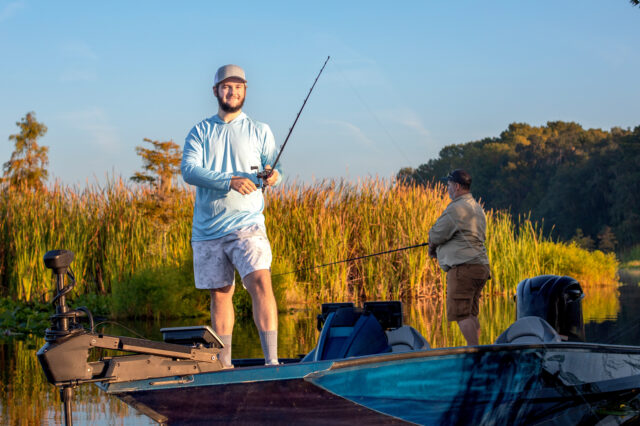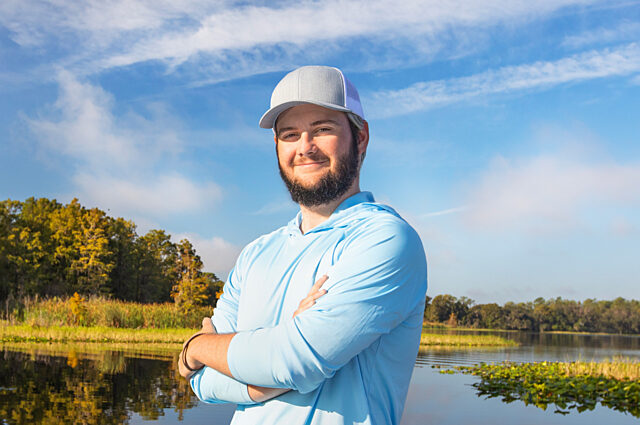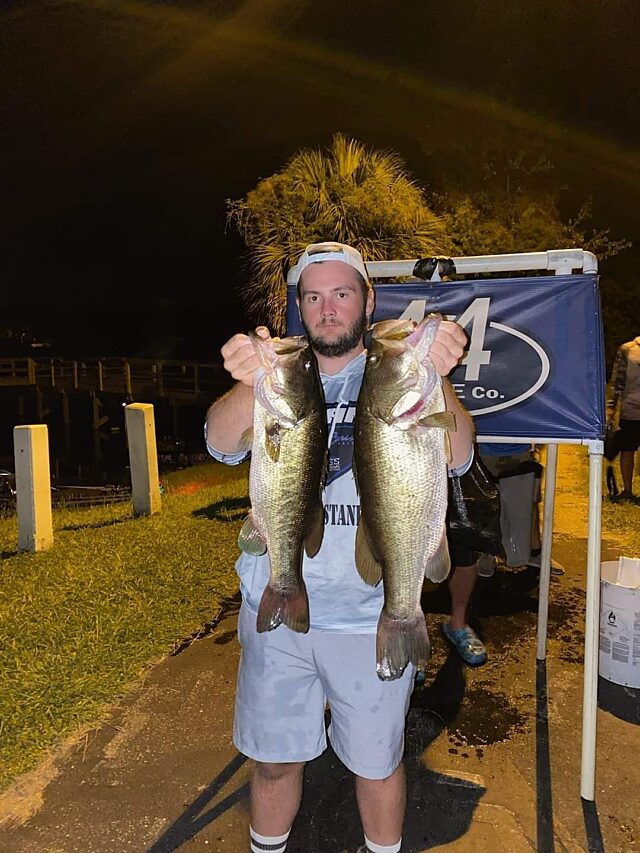After Struggle With Unseen Threat, Taylor Returns to the Water

Taylor Green gazes across his favorite place in the world, scanning the top of Lake Panasoffkee’s spring-fed water. But, in many ways, this 20-year-old pro bass fisherman’s life has been defined by what lies below the surface.
“Most people don't catch fish because they don’t put the time in,” said Taylor, who began fishing at age 5 before transitioning to bass fishing at 15. “It’s also a timing thing. People come into the bait shop and they’re going out at 10 a.m. It’s already 90 degrees. They’ve already missed the bite.”
For a competitive angler like Taylor, catching fish requires just as much spirit as it does science. He bases his tactics on the weather forecast and if he’s preparing for pre-cold front or post-cold front conditions. He’s studied fish behavior in every environment. He pays attention to the color of the fish, the kind of cover they’re in, even the color of their tongues so he can figure out what they’re eating to mimic their diet for lures.
How Taylor got reeled into fishing is a lot simpler to explain.
“It’s just being on the water,” Taylor said. “It’s getting out there, you get to watch the sunrise, you’re with the people you love the most, and the excitement of getting the hooks out on the fish and fighting ’em. Man, it’s everything.”
Taylor wasn’t aware that he was fighting another foe under the surface, undetected for years, that would put his lifelong passion in jeopardy. The first signs came during his freshman year at Citrus High School.
The biggest catch of his life
“It just looked like static television in my eyes,” Taylor said. “I couldn’t see absolutely anything but that. I had to stop walking so I wouldn’t run into everything. I would never know how long it would last. It could be 5 seconds or it could be 30 seconds, so it was pretty scary.”
One week before his sophomore year started, a local doctor examined his eyes and wouldn’t say what he spotted. However, he made it clear Taylor should go immediately to UF Health Shands Hospital.
His family went to an emergency room before he was admitted to the pediatric oncology unit, and an MRI revealed something massive: a brain tumor the size of a large orange.
“The neurosurgeon came in, and I truly did ask him if I was going to die. He said there’s a big chance I could die,” Taylor said. “I didn’t want to leave my family. I had friends, I had animals, so I didn’t want to leave any of them behind like that.”
The devastating diagnosis was ganglioglioma, a rare tumor that only accounts for about 1% to 2% of all brain tumors. Whether gangliogliomas are classified as cancer falls in a gray area among physicians, as they are generally benign but still have high regrowth potential and share the same treatment methods as cancer.
Gangliogliomas start from groups of ganglion and glial nerve cells and grow in the brain. In Taylor’s case, the tumor had grown large enough to occupy roughly a quarter of his head.
It was life-altering news for a 15-year-old from Inverness, Florida, who loved fishing and the panoramic, postcard-worthy scenery that came with it. The perspective was vastly different now from his hospital room as the tumor didn’t allow much of a view beyond its four walls.
Going into harm’s way
During his stay at UF Health Shands Children’s Hospital, all Taylor could do was look over at the new rods and reels in the corner that his boss gave him as a gift. Each time he’d ask a nurse or family member to bring a rod over to his bed, holding one would temporarily transport him to a hot spot in Lake Okeechobee or a cozy nook in Lake Rousseau.
For Taylor to ever visit those places again, he’d need to let UF Health neurosurgeon Jason Blatt and his team take the wheel. While Dr. Blatt has navigated patients through many complex brain surgeries, this one had plenty of pitfalls as there were vital structures all around the tumor.
“I've performed thousands of surgeries,” Dr. Blatt said. “Taylor's surgery was extremely challenging because his tumor had grown dozens of massive blood vessels within itself, such that it almost looked like a bird's nest of arteries.”
During the 10-hour procedure, Dr. Blatt managed to remove most of the mass but some had to stay because of the risk of stroke. Even for Dr. Blatt, an experienced neurosurgeon, the operation was uniquely challenging.
“I knew that there was an extremely high likelihood of life-threatening bleeding from the tumor as we cut into it, and some of the blood vessels couldn't be sacrificed without risking a stroke to the healthy parts of his brain,” Dr. Blatt said. “This made surgery especially risky in several ways. He ended up losing almost 4 liters of blood during his operation, but thankfully he did not suffer a stroke.”
However, Taylor wasn’t in the clear yet. Following the procedure, he experienced hydrocephalus, an abnormal buildup of cerebrospinal fluid in the brain. The excess fluid causes the ventricles to widen, putting pressure on the brain that can permanently damage it. UF Health’s team was successful in putting a shunt in Taylor’s head to drain the fluid to another part of the body where it could be absorbed — in this case, his stomach.
With that complication now in his wake, he still needed to find a way past the remaining tumor and its high regrowth potential. He underwent multiple types of chemotherapy treatments, in pill and liquid form. Some of them had horrible side effects, so UF Health doctors helped him sign up for a clinical trial with just 44 patients testing a medication now known as DAY101.
Taylor still takes the medication today and feels “phenomenal” as it’s effectively kept the tumor in check.
“When he comes off treatment, the tumor starts to grow again, but the medications seem to shrink it back to a small size,” Dr. Blatt said. “Tovorafenib (DAY101) has been especially helpful for him because he had fewer side effects than he did on other medications like trametinib (Mekinist). One remarkable side effect of DAY101 is that his hair turned blonde. I barely recognized him at our first clinic appointment after starting the treatments!”
Back on his hook
Taylor had spent a month at UF Health Shands Children’s Hospital before he went home, but he didn’t feel at home until a memorable autumn day a week later. That’s when he made it back to one of his haunts.
“We went out and we just caught a bunch of fish that day, mostly bass,” Taylor said. “I love fishing and being on the water. It’s where I belong.”
That was five years ago. Since then, Taylor has made waves all over the state as a professional bass fisherman. With his focus on freshwater, he’s won several events or earned top five finishes in bass tournaments throughout Florida, such as the Lake Panasoffkee Tuesday Nighter, Lake Henderson Wednesday Nighter, Citrus Bass Open Tournament and Xtreme Bass Series.
Fishing is a passion Taylor shares with his father, James Green, who sometimes helps serve as Taylor’s eyes during competitions due to Taylor’s vision being impeded by the tumor. Together, Taylor, James and his father’s friend Eric created a team called Out-Fishing-U. They’ve enjoyed a five-year streak as winners in the Florida Children’s Brain Tumor Association “Kids Against Cancer Saltwater Classic” in Crystal River, Florida.
All those moments might have never happened. Taylor thinks about that as he looks out at the water from his boat, a TR20 Triton that has the UF Health logo and his doctor’s name emblazoned on it — a reminder of the health care workers who steered him back to where he felt the most alive.
“My doctors at UF Health knew exactly how to treat me. Now I’m healthy, and I get to come out here and do what I love most,” Taylor said. “That tumor almost took this away from me.”
About the author



